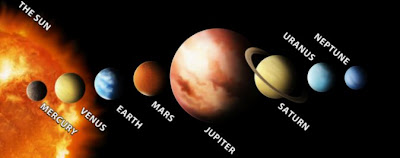 |
| Nine Planets and the Sun |
Solar System means the system of the Sun. All bodies under gravitational influence of our local star, the Sun, together with the sun formed the Solar System. The largest bodies are called planets. The cool bodies which are smaller and revolve around the planets in its orbit are called natural satellite or moons. Smaller bodies which orbit the Sun are called asteroids if they are rocky or metallic, comets if they are mostly ice and dust and meteoroids if they are very small. It formed 4.6 billion years ago from the gravitational collapse of a giant molecular cloud.
1. Which are the terrestrial planets?
 |
| Ganymede, the largest natural satellite of solar system is named after the mythological Ganymede, cupbearer of the Greek gods and Zeus's lover. |
Ans: Mercury, Venus, Earth and Mars.
2. Mars is the fourth planet from the Sun and the second smallest planet in the Solar System. Mars was name after Roman God of war. It is also known as the “Red Planet”. Mars is the only planet to have same features as of Earth.
3. Name two dwarf planets other than Pluto.
Ans: Eris and Haumea.
4. Pluto is the second most massive known dwarf planet in the Solar System. Pluto was considered as the Ninth planet from the Sun but was re-categorized.
5. Which is the largest known natural satellite of the solar system?
Ans: Ganymede (Jupiter).
6. Jupiter is the largest planet of the solar system. Jupiter has 67 natural satellites. The four largest satellites Ganymede, Callisto, Io, and Europa are known as the "Galilean moons".
7. Who was the first astronomer to develop mathematically predictive heliocebtric system?
Ans: Nicolaus Copernicus of Kingdom of Poland (1473-1543).
8. Telescope was first invented in the Netherland at the beginning of the 17th centuary using glass lenses and then by Galileo. The invention of the telescope led to the discovery of further planets and moons.
9. What is the name of the largest known asteroids?
Ans: Ceres.
10. The unmanned Dawn spacecraft which was launched on 27 September 2007 by NASA, is expected to be the first to explore Ceres after its scheduled arrival there in 2015.
Ans: William Herschel in 1781.
12. Triton is the largest known moon of the planet Neptune. It was discovered on October 10, 1846 by
English astronomer William Lassell.
Ans: Neptune.
14. Mercury was named after the messenger of the Gods. Venus was named after the Roman god of Love. Earth is the only planet that was not named after a God. Earth’s name was based on Germanic and old English word for “ground”. Mars was named after Roman god of war. Jupiter was named after King of Gods. Saturn was named after the god of agriculture and harvest. Uranus was named after the Roman god who was father of Jupiter. Neptune was named after the Roman god of sea.
 |
| Milky Way |
15. What is the name of the spiral arm of the Milky Way in which our Solar System resides?
Ans: Orion-Cygnus Arm.
16. The nearest galactic neighborhood of the Solar System is known as the Local Interstellar Cloud or Local Fluff, an area of denser cloud in an otherwise sparse region known as the Local Bubble.


No comments:
Post a Comment
Thank You For Comment